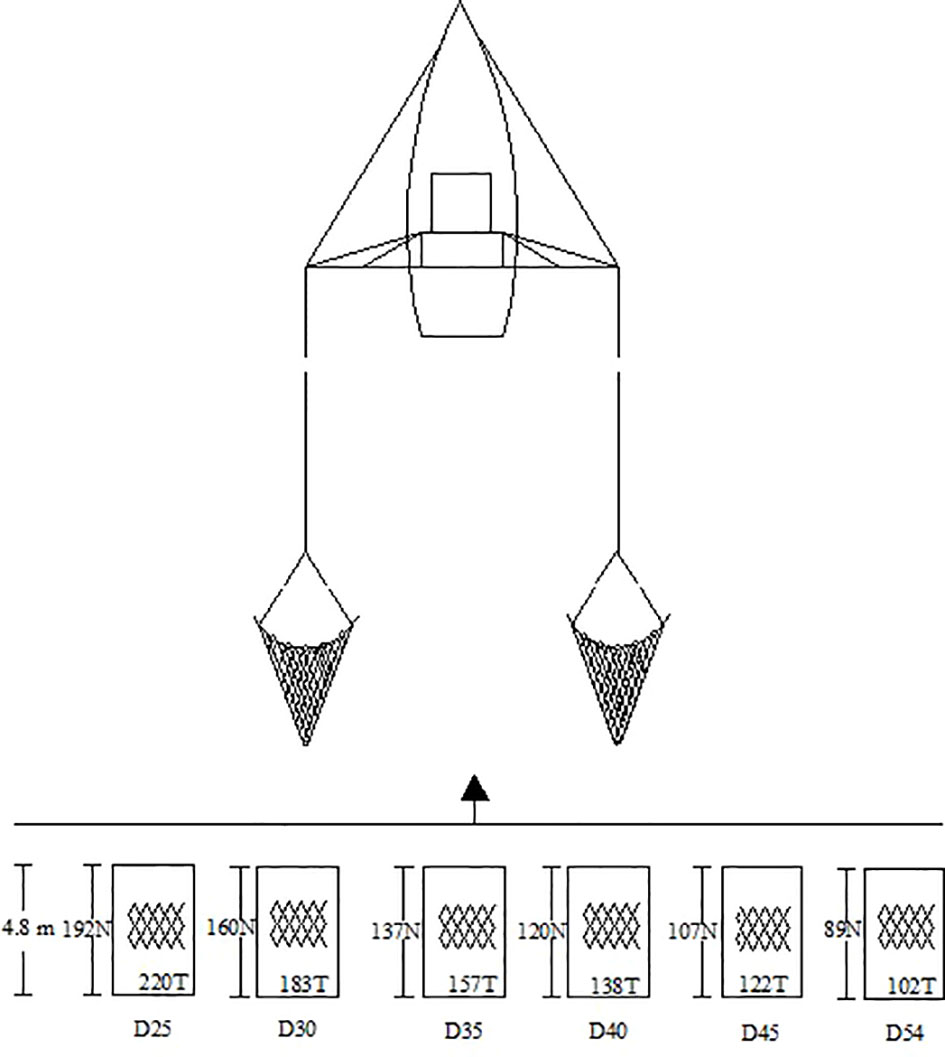- 1South China Sea Fisheries Research Institute, Chinese Academy of Fishery Sciences, Guangzhou, China
- 2Key Laboratory of Open-Sea Fishery Development, Ministry of Agriculture and Rural Affairs, Guangzhou, China
- 3SINTEF Ocean, Fishing Gear Technology, Hirtshals, Denmark
- 4Uit, The Arctic University of Norway, Tromsø, Norway
- 5DTU Aqua, Technical University of Denmark, Hirtshals, Denmark
This study aims at improving fishery management by testing and comparing the size selectivity and exploitation pattern of diamond-mesh codends, with mesh sizes ranging from 25 to 54 mm, for cocktail shrimp (Trachypenaeus curvirostris) in the South China Sea (SCS). Beginning from 25 mm, the minimum mesh size regulated by the shrimp trawl fishery industry, we investigated how the mesh sizes of the codends would affect the size selectivity and exploitation pattern in reference to the minimum conservation reference size (MCRS, 7.0 cm total length) of cocktail shrimp in the SCS. According to our results, the selective properties of the codend mesh sized at 25 mm in line with the regulation failed to protect the undersized individuals of cocktail shrimp because of its 50% retention length of 5.85 cm (confidence interval, CI: 5.16–6.18 cm), far less than the MCRS of cocktail shrimp. As the retention probability of a shrimp with a MCRS length was as high as 97.45 % (CI: 86.86–100.00%), more than 40% of the undersized shrimp was retained. It was proved that increasing the codend mesh size did not significantly improve the size selectivity and exploitation pattern which might be improved by other gear modifications.
Introduction
Cocktail shrimp (Trachypenaeus curvirostris) is one of the most ecologically and economically important shrimp species and one of the commercial shrimp species leading the annual landings officially recorded in China (e.g., China Fishery Statistical Yearbook), being distributed in all the coastal waters around China (Liu and Zhong, 1988). Its annual landings fluctuated between 240,249 t and 366,120 t in the past decade, during which the catch stabilized at about 300,000 t between 2011 and 2017, highlighted in 2015. However, the annual landing dropped to 245,035 t in 2018 and to its lowest in 2020 (Figure 1), indicating the stock decline and the overexploitation of cocktail shrimp as demonstrated in some previous surveys (Song et al., 2004).
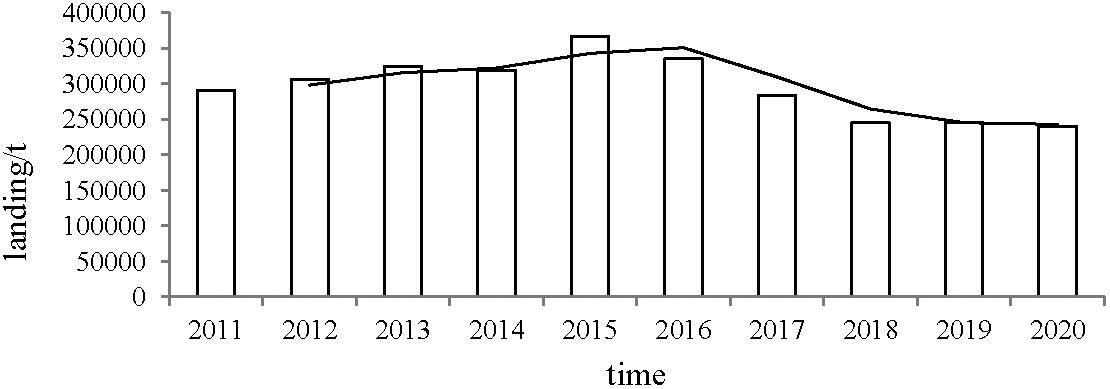
Figure 1 Annual landing of cocktail shrimp in China (data from China’s Fisheries Statistical Yearbooks).
The decline and overexploitation of cocktail shrimp stock can be attributed to many factors, especially the fishing gears used and management regulations implemented. Normally, beam trawl and double-rigged trawl are used to target cocktail shrimp due to their high catching efficiency in China (Liu and Zhong, 1988). In spite of their difference in gear components, they are both subjected to one common management regulation—a minimum mesh size (MMS) of 25 mm in the codend, leading to the wide questioning, scepticism, and criticism on the effectiveness and compliance of this MMS regulation (Cao et al., 2017; Liang and Pauly, 2017; Zhang et al., 2020; Zhang and Vincent, 2020). The confusion might be caused by the knowledge gap of selective properties of trawl codend used for catching commercially important species like cocktail shrimp. Unfortunately, the issue is seldom addressed in the perspective of gear selectivity even though low compliance has been outlined in the literature.
It is time to tackle the above-mentioned issue by investigating the codend selectivity for cocktail shrimp based on two experiments on the size selectivity of trawl codends for cocktail shrimp before the MMS regulation was in place for shrimp trawl in 2013. One was conducted in the East China Sea by Sun and Wang (1999), who found that the 50% retention length (L50) was 85.04, 85.96, and 88.32 mm for the diamond mesh codend with a mesh size of 40, 45, and 50 mm, respectively. Later, the other experiment was carried out in the Yellow Sea by Tang et al. (2010) who used three relatively smaller mesh sizes of 30, 33, and 40 mm and got a lower L50 of 59.8, 60.1, and 63.2 mm for the corresponding codends. Given the MCRS of 70 mm (total length of the cocktail shrimp) in the first maturity length (Song et al., 2012), the minimum mesh size of 25 mm might be too small to have a sustainable exploitation pattern. So far, no selectivity result has been documented from either of the experiments, leaving no data for us to evaluate the effectiveness of the MMS regulation for cocktail shrimp in China.
Increasing the mesh size has been proved to be the most simple and effective option to improve the size selectivity of a diamond mesh codend for some species (Wileman et al., 1996; Fryer et al., 2016; O’Neill et al., 2020). L50 and selection range (SR) can be referred to as parameters for size selectivity. Usually, larger mesh sizes in the codend bring about larger L50 values so that more undersized individuals of the target species can be released (He, 2007; Melli et al., 2020; Yang et al., 2021a; Yang et al., 2021b). However, the probable increase of SR values, if exceeding a certain extent, would induce the loss of marketable individuals. Experiments on selectivity are needed to find out the best mesh size that can reach a balance between releasing undersized individuals and maintaining the marketable ones. Additionally, it is imperative to inform the stakeholders how the modification in mesh size of codend would impact the exploitation pattern for their fishing gears (Kennelly and Broadhurst, 2021). This information can be presented by using the exploitation pattern indicators which have been widely used in recent selectivity studies (Wienbeck et al., 2014; Melli et al., 2020; Brinkhof et al., 2020; Herrmann et al., 2021). However, no study concerning the exploitation pattern of trawl codend for cocktail shrimp in the South China Sea (SCS) has been reported so far.
This study aims to address the issues mentioned above by investigating the size selectivity and exploitation pattern of diamond mesh codends for cocktail shrimp in the SCS. We started from 25 mm, the mesh size regulated in the current MMS, and tested six different mesh sizes of 25–54 mm to find out (1) how selective properties of the legal codend with a 25-mm mesh size can fit for cocktail shrimp and (2) whether increasing the mesh sizes of diamond mesh codends can improve the size selectivity and exploitation pattern for cocktail shrimp.
Materials and methods
Experimental setup
The experimental fishing was performed on board Guibeiyu 96899, a 38-m-long commercial trawler of 280-kW engine power, in October 2019 at the area of 20°50′–21°11′ N and 109°06′–109°31′ E northern of the SCS. The maritime operation, such as towing speed and duration, was in line with what is required in commercial fishing.
The fishing vessel employed was equipped with a double-rigged trawling system, hauling two identical trawls simultaneously during the commercial fishing. These trawls had 860 meshes in the fishing circles with a size of 45 mm, and the total stretched length was about 33 m. Two identical sets of trawl doors (weighing 250 kg), made of steel and wood, were applied for the spreading of these trawls.
Focusing on codend selectivity, we adopted the gear components of the commercial vessel except the codends. Six diamond mesh codends with different mesh sizes were designed based on the dimension of the commercial codend, which had 220 meshes in circumference and 192 meshes in length, with a mesh size of 25 mm. We ordered the codends from the local manufacturer of fishing nets, with the following requirements: (1) nominal mesh size (mesh opening) of 25, 30, 35, 40, 45, and 54 mm and (2) being identical to the commercial codend in terms of twine material, color, twine diameter, etc. Additionally, the number of meshes in the codends, both in circumference and length, was designed to decrease as the mesh sizes increased so as to ensure the same stretched width and length of all the codends which were termed as D25, D30, D35, D40, D45, and D54, respectively, according to their mesh sizes. In order to collect the escapees from the codends tested, the covered codend method was applied following the protocol of Wileman et al. (1996). The cover was 1.5 times larger than the codends both in circumference and length (see Figure 2 and Table 1 for the detailed information about the codends and cover). We used 12 sets of flexible kites, made of waterproof canvas, to minimize the potential masking effect, following the recommendation of He (2007) and Grimaldo et al. (2009). Prior to the experiments, the working of the kites was checked by the underwater cameras of GoPro HERO4 BLACK Edition, subject to adjustments if needed.
To facilitate the selective experiments, we made good use of the double-rigged trawling system by testing two codends at a time as follows: D25 vs. D30, D35 vs. D40, and D45 vs. D54, in the hope of finding out how the mesh size of codends would affect the size selectivity for the species studied. Using the covered codend method, we tested one comparison at a time for several hauls before moving on to another test, during which the unified operation procedure was ensured in each of the comparison tests, including the towing speed, duration and length of warp, etc. In every test, the catch of cocktail shrimp from each compartment, cover, and codend was handled separately. All the catches of cocktail shrimp were collected and sub-sampled (if the catch was in a large quantity) before being frozen in specifically marked containers. We measured the total length of all the cocktail shrimp individuals immediately after returning to the laboratory, accumulating basic data for further analysis on selectivity.
Estimation of size selectivity and exploitation pattern indicators
The experimental data of each codend tested was binominal as the shrimp was caught by either the codend or the cover. The catch proportion [rj(l)] of a shrimp in length l within a specific haul j can be easily calculated using the catch quantity from the codend and the cover. The value of rj(l) for the same codend might vary between different hauls (Fryer, 1991). What we focus on, however, was the average value of rj(l) among all hauls conducted, assuming that it would represent how the tested codend perform in a commercial fishery (Millar, 1993; Sistiaga et al., 2010). By incorporating some selectivity parameters, rav(l,v) was used to represent the average size selectivity of a specific codend by pooling the data from all the hauls (Herrmann et al., 2012), where v is the parameter yet to be estimated. Combining the catch data from the cover and the codend and some parametric models, v parameters can be obtained by minimizing the following likelihood function:
where the outer summation is over the m hauls conducted for the codend tested and the inner summation is over the length class l of cocktail shrimp; nRjl and nEjl are the quantity of cocktail shrimp caught by the codend tested and cover, while qRj and qEj are the sampled ratio of cocktail shrimp length measured from the codend and the cover, respectively.
We used four parametric models, Logit, Probit, Gompertz and Richards, as candidates to describe rav(l). For the first three models, two parameters (L50 and SR) can describe, while an additional parameter (1/δ) is required for the last model (Wileman et al., 1996). These candidate models were initially fitted in Eq. (1) to obtain their Akaike information criterion (AIC) values. The model with the lowest AIC value was regarded as the best one (Akaike, 1974) and selected for further analysis. After the best model was selected, a double bootstrapping method was applied to calculate the confidence intervals (CIs) of the selectivity parameters and selectivity curves by incorporating both within- and between-haul variations (Millar, 1993; Herrmann et al., 2012; Herrmann et al., 2018). A total of 1,000 bootstrap repetitions were conducted to estimate the Efron percentile 95% CI for the size selectivity curves and parameters (Herrmann et al., 2012; Herrmann et al., 2018). Finally, the ability of the selected model to describe the experimental data can be evaluated by the p-value. For a good-fit model, the p-value is expected to be larger than 0.05, with a deviance less than a degree of freedom; otherwise (p-value<0.05), the residuals will be inspected to find out whether it was caused by the structural problems or just overdispersion in the data (Wileman et al., 1996).
In addition to the selectivity parameters and curves mentioned above, we calculated four exploitation pattern indicators—nP-, nP+, nRatio, and dnRatio—and informed the stakeholders as to how the codends tested would perform in the commercial fishing population scenario. To generate such a fishing population scenario structure (nPopl) for the studied species, we pooled the length data of all tests from both covers and codends (Melli et al., 2020; Einarsson et al., 2021). By taking into consideration the MCRS of the cocktail shrimp (70 mm total length), these exploitation pattern indicators can be obtained by Eq. (2):
where rav(l, v) is the size selectivity of the codend tested, and nPopl represents the population structure (in terms of relative frequency) of the target shrimp. nP- and nP+ is the percentage of cocktail shrimp caught with length below and above the MCRS. nRatio refers to the ratio between cocktail shrimp caught with length below and above the MCRS, while dnRatio is the percentage of cocktail shrimp with length below the MCRS caught by the codends tested. For a tested codend with ideal selective properties, nP- is preferred to be close to 0 and nP+ preferred to be close to 100%, while both nRatio and dnRatio are preferred to be low. The CIs of these indicators were obtained using the double bootstrapping approach mentioned above (Herrmann et al., 2012; Herrmann et al., 2018).
Length-dependent difference in selectivity
It is assumed that the size selectivity would be improved when the mesh sizes of the codends increased. This improvement can be reflected by quantifying the length-dependent selectivity difference, delta selectivity [Δr(l)], between codends with different mesh sizes as follows:
where r1(l) is the size selectivity of codend 1 with a small mesh size, and r2(l) represents the size selectivity of codend 2 with a relatively larger mesh size. The CIs for the delta selectivity can also be acquired with the double bootstrapping technique (Herrmann et al., 2018; Herrmann et al., 2019). Whether the length-dependent difference is statistically significant or not depends on whether its CIs contain 0.0 or not. In other words, the difference would be significant if the CIs did not contain 0.0.
All the data analyses mentioned above were conducted using the software SELNET (Herrmann et al., 2012).
Results
Overview of the sea trials
A total of 39 valid hauls were conducted, of which six were for the D25, D35, D45, and D54 codends, eight for the D30 codend, and seven for the D40 codend. The experimental fishing was performed in an average duration of 131 min (118–156 min) in the water of 16 m in depth (12–24 m) of the fishing grounds (Table 2). In all these hauls, cocktail shrimp was one of the leading species in terms of quantity, on which we focus for selectivity analysis. Among the total of 1,231 individuals of cocktail shrimp that were identified and measured in length, 725 were from the codends tested and 507 were from the cover, with a sub-sampling ratio of 0.20–1.00 (Table 2). The length of the species varied from 3 to 11 cm, being mostly from 5.5 to 6.5 cm (Figure 3).
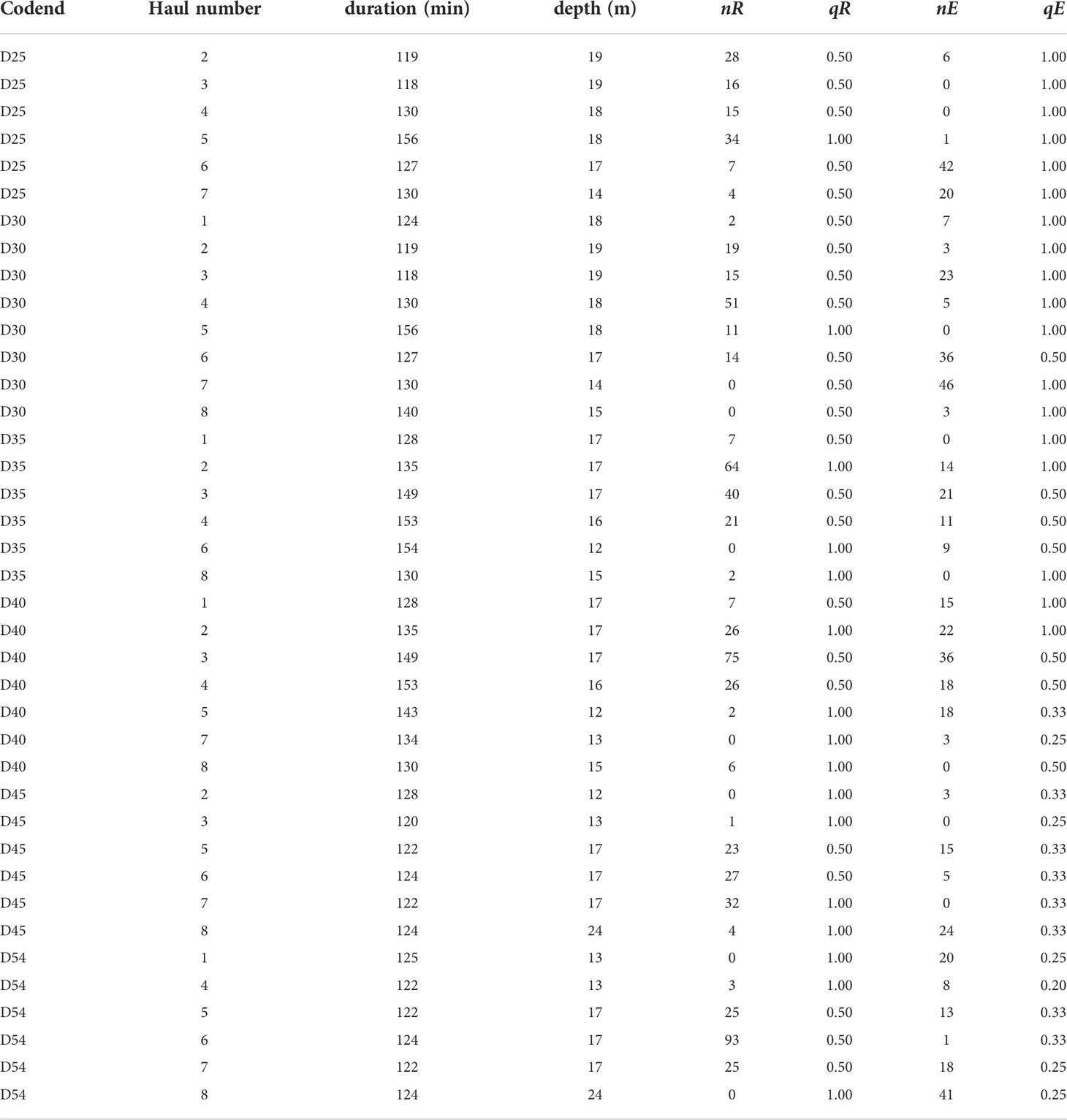
Table 2 Overview of the fishing condition and catch information of all the hauls regarding the serial number, duration (min), depth (m), and number of shrimp length-measured from the codend (nR) and cover (nE). qR and qE refer to the sampling ratio from the codend and cover, respectively.
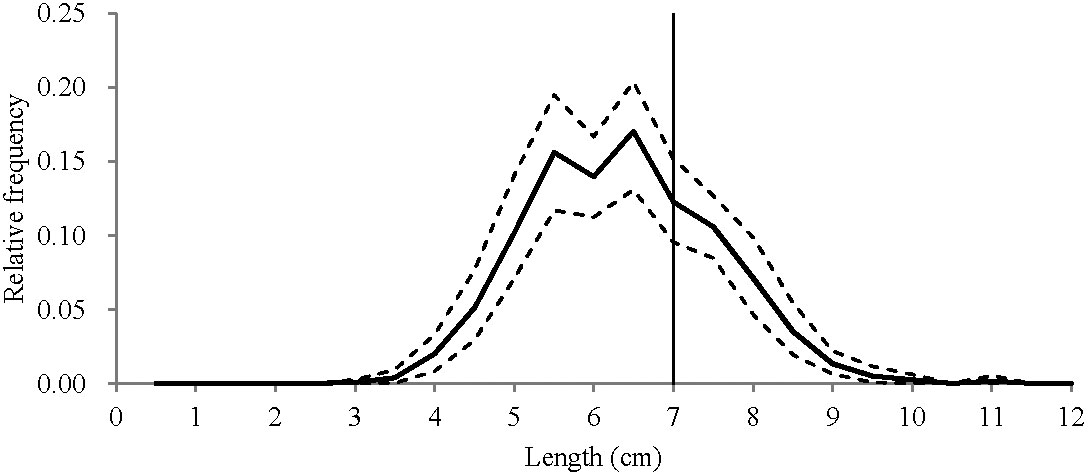
Figure 3 Estimated average population of cocktail shrimp from all the hauls during the sea trials. Stipple lines show the 95% Efron confidence intervals, and the vertical line represents the minimum conservation reference size (7.0 cm) of the target shrimp.
Size selectivity and exploitation pattern
According to the lowest AIC value criterion, the best model was selected respectively for each codend as follows: the Gompertz for the D25, D45, and D54 codends, the Richards for the D30 and D35 codends, and the Logit for the D40 codend (Table 3). The selected models were sufficiently able to fit the experimental data as they all obtained p-values larger than 0.05, except for the D25 codend which resulted in a p-value lower than 0.05 (Table 4). As the fitness of selectivity curve stands for the main trend of the experimental data for this codend (Figure 4A), we came to the conclusion that the lower p-value resulted from the overdispersion in the data.The selective parameters, both L50 and SR, showed an incremental trend as the mesh sizes increased—for instance, L50 and SR were 5.85 and 0.55 cm, respectively, for the D25 codend; when the mesh size was increased to 54 mm (D54), the values were 6.61 and 1.67 cm, respectively. The differences in L50 values, however, were not statistically significant as their CIs overlapped. A similar trend was obtained for the SR values, except that the SR of the D54 codend was significantly larger than those of the D25 and D30 codends (Table 4). The L50 values smaller than the MCRS led to a relatively higher retention probability of the codends tested for cocktail shrimp with a MCRS length (Figure 4)—for instance, the retention probability values were all above 95% for D25, D30, and D35 codends but dropped to 87 and 79% for the D40 and D45 codends, respectively, even to 62% for the D54 codend.
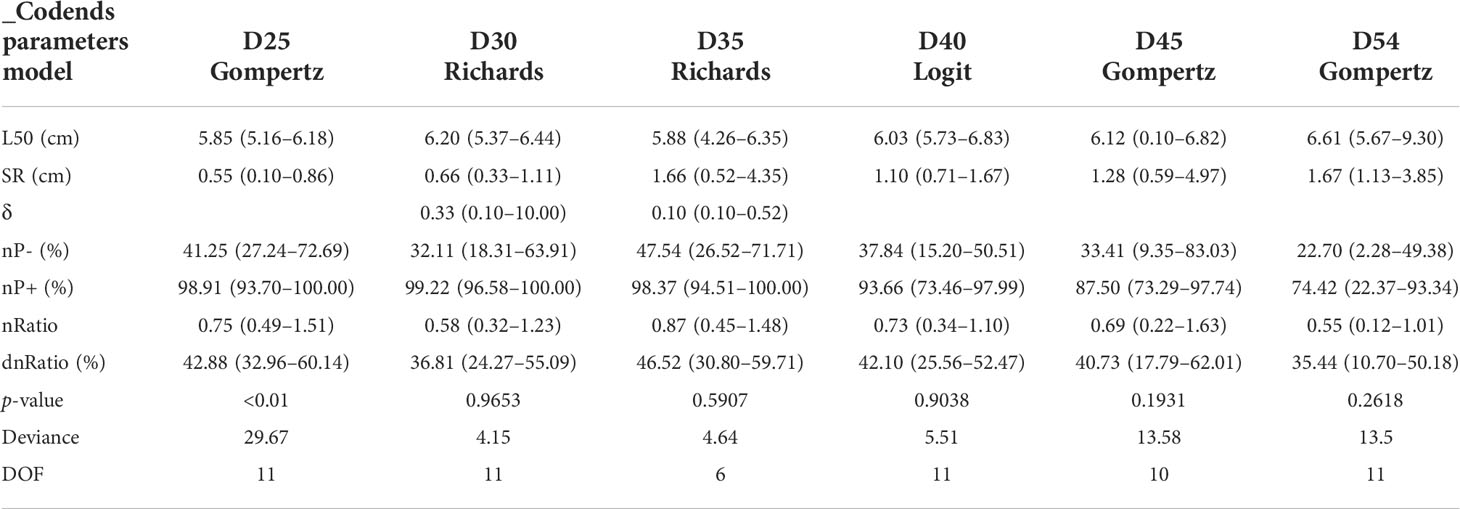
Table 4 Selective parameters, fit statistics, and performance indicators obtained from the selected models for the codends tested.
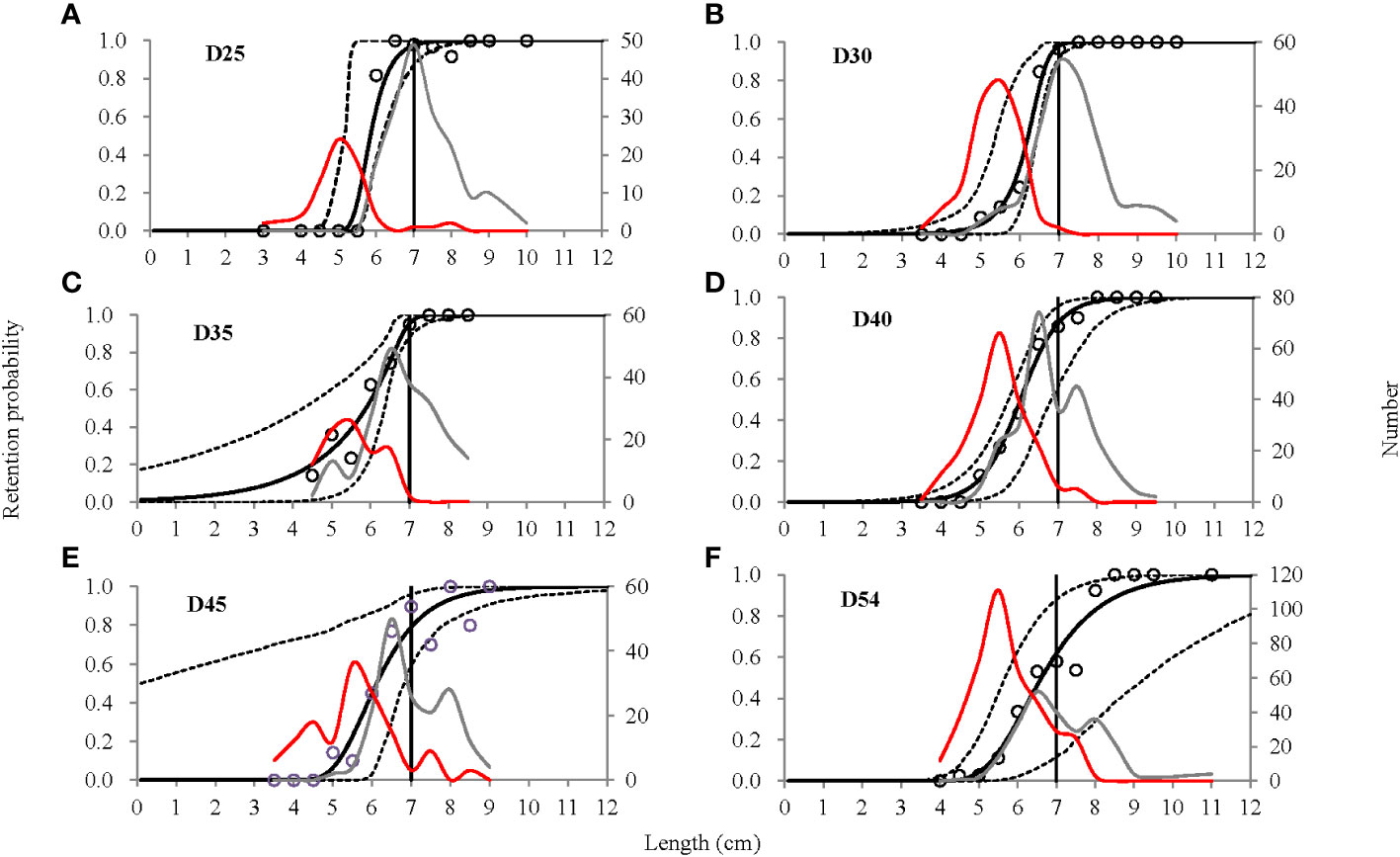
Figure 4 The experimental catch proportion and selectivity curves are obtained for the tested codends. The circular marks represent the experimental catch proportion. The red curves represent the size distribution of shrimp caught by the cover, and the gray curves represent the one caught by the tested codend. The solid black curves represent the selectivity curves, and the stippled curves describe the 95% confidence intervals. The vertical lines represent the minimum conservation reference size (7.0 cm) of the target shrimp. (A–F) represents the D25, D30, D35, D40, D45 and D54 codend, respectively.
The exploitation pattern indicators showed the decrease of catch efficiency of codends for the target shrimp, both for the undersized (nP-) and legal-sized (nP+) individuals, when the mesh sizes increased. The differences in catch efficiency of the undersized shrimp were not statistically significant due to the overlapping CIs. Differences in catch efficiency of the legal-sized individuals were also insignificant except that the D54 codend caught far less shrimp than the D25 and D30 codends, respectively (Table 4). Similar nRatio values were obtained for all codends, ranging from 0.55 to 0.87. High discard ratios (dnRatio) were obtained for all the codends, all above 35%, with no significant difference found.
Length-dependent difference in selectivity
The result of delta selectivity showed that there was no significant difference in retention probability among the four codends with smaller mesh sizes (D25, D30, D35, and D40) because their CIs contained 0.0 (Figure 5). Compared with the D25, D30, and D35 codends, the D45 codend had a significantly lower retention probability for cocktail shrimp at the following range of length: 7.2–9.6, 7.0–12.0, and 7.3–12.0 cm (Figure 6). A similar trend was obtained for the D54 codend with a significantly low retention probability for cocktail shrimp at the following range of length: 6.3–12.0, 6.7–12.0, and 6.6–12.0 cm, in comparison with the D25, D30, and D35 codends, respectively (Figure 6). No significant difference was found in any of the following comparisons: D45 vs. D40, D54 vs. D40, and D54 vs. D45.
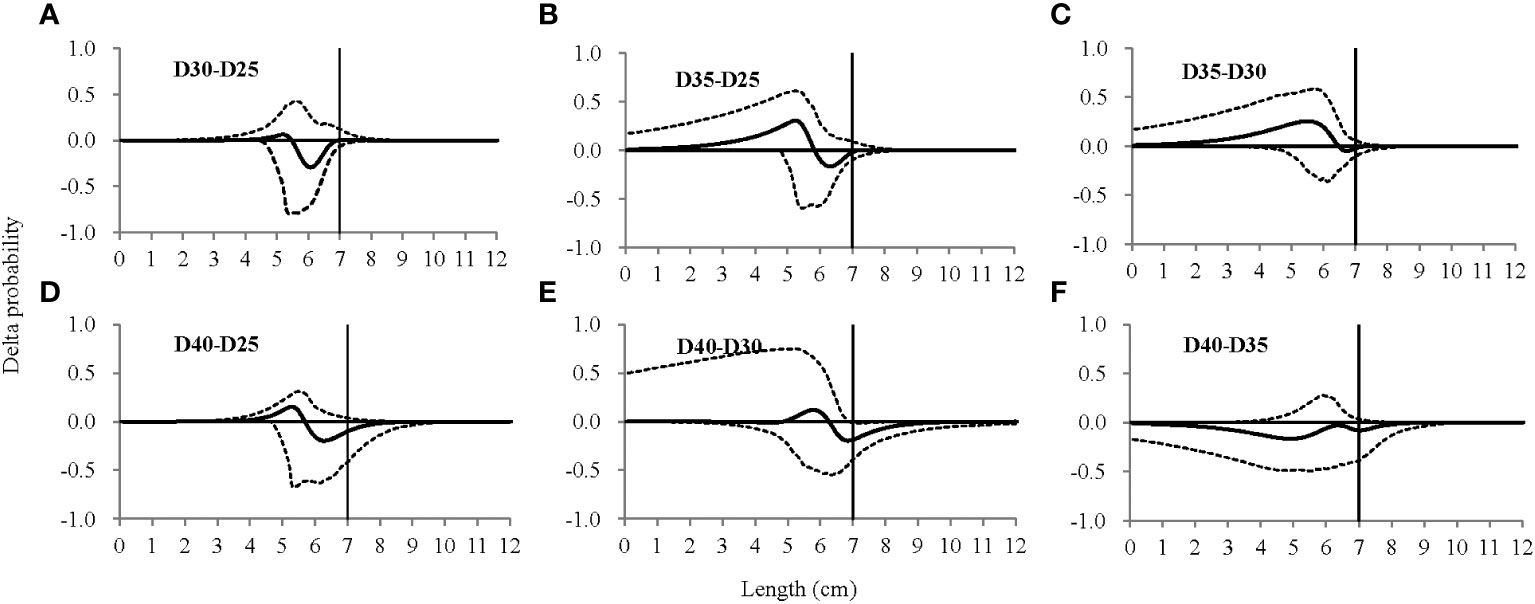
Figure 5 Delta selectivity from the comparison among four codends—the D25, D30, D35, and D40 codends. The solid black curves represent the delta selectivity for each comparison, and the stippled curves represent the 95% confidence intervals. The vertical lines represent the minimum conservation reference size (7.0 cm) of the target shrimp. (A–F) represents the D30-D25, D35-D25, D35-D30, D40-D25, D40-D30 and D40-D35 comparison, respectively.

Figure 6 Delta selectivity from the comparison among six codends—the D25, D30, D35, D40, D45, and D54 codend. The solid black curves represent the delta selectivity for each comparison, and the stippled curves represent the 95% confidence intervals. The vertical lines represent the minimum conservation reference size (7.0 cm) of the target shrimp. (A–I) represents the D45-D25, D45-D30, D45-D35, D45-D40, D54-D25, D54-D30, D54-D35, D54-D40, and D54-D45 comparison, respectively.
Discussion
The documentation of this study marks the first of its kind in history concerning the size selectivity and exploitation pattern of diamond-mesh codends for cocktail shrimp in the SCS. The selective properties of the minimum legal mesh size codend, D25 codend, were proved dissatisfactory in protecting undersized individuals of cocktail shrimp. It obtained a L50 of 5.85 (CI: 5.16–6.18) cm, far less than the MCRS of cocktail shrimp. The retention probability was as high as 97.45% for the shrimp with a length of MCRS (CI: 86.86–100.00%), retaining more than 40% of undersized shrimp, which implies that the current MMS regulation probably has little effect on protecting undersized individuals of cocktail shrimp in the sea area studied. During the fishing seasons when the undersized resources of cocktail shrimp is abundant in the fishing grounds of the SCS, it is important for the shrimp fishing fleets to consider changing their fishing dynamic (fishing time and location) or applying other gear modifications. Our results also demonstrated that increasing the mesh sizes did not have a significant effect on improving the size selectivity and exploitation pattern of the studied species. Compared with the starting point (D25), codends with larger mesh sizes failed to obtain significantly larger L50 values. The exploitation pattern indicators also showed a similar tendency due to the overlapping CIs. Additionally, the loss of marketable individuals in the codend with the largest mesh size (D54) was more significant in comparison with the codends of D25, D30, and D35 with smaller mesh sizes, respectively.
It has been demonstrated that the size selectivity of a diamond-mesh codend not only depended on the gear configuration but also was affected by the morphology and swimming behavior of the target species (Herrmann et al., 2009; He, 2010). There are speculations that the poor selective properties of the tested codends for cocktail shrimp might be associated with its morphology, swimming capacity, and in which direction it contacts the open meshes, but no literature addressing the swimming behavior/capacity of cocktail shrimp has been found. It is time to do a study and make observations on it.
As the first of its kind in the research history about the size selectivity of diamond-mesh codends for cocktail shrimp in the SCS, our result finds no previous study based on which they can be compared with each other. Fortunately, relevant experiments conducted across the country can be referred to as this shrimp species is widely distributed in all coastal waters of China. About a decade ago, a size selectivity experiment of diamond-mesh codends for cocktail shrimp was conducted by Tang et al. (2010) using a traditional otter board trawl (single trawl) with three mesh sizes of 30, 33, and 40 mm in the Yellow Sea. Their results showed that L50 was 5.98, 6.01, and 6.32 cm, while SR was 1.44, 1.60, and 2.29 cm for the three codends, respectively. In the late 1990s, Sun and Wang (1999) carried out a selective experiment of shrimp beam trawl for cocktail shrimp with three diamond-mesh codends with mesh sizes of 40, 45, and 50 mm, respectively. They got larger L50 as 8.50, 8.60, and 8.83 cm, and SR was 1.39, 1.39, and 1.50 cm for the three tested codends. By comparison, the L50 values in our study seem close to those of Tang et al. (2010) and lower than the values of Sun and Wang (1999). We are still not sure whether these differences are statistically significant or not, as the two previous studies failed to present CIs and/or standard errors in their articles. The method of data analysis was different between our study and the previous studies, as they did not take into account the uncertainties from both within-haul and between-haul variations. In addition, our study and theirs vary a lot in the gear configuration, fishing condition, and fishing population, whereas a previous study demonstrated that there was a significant genetic differentiation for cocktail shrimp captured in different areas (Han et al., 2015).
Irrespective of the differences between experiments on cocktail shrimp as mentioned above, our study provides an insight into future research on the related selectivity and fishery management. As increasing mesh sizes has little effect on improving the size selectivity of diamond mesh codends for cocktail shrimp, other modifications are expected to be tested and documented, such as using T90 codend (diamond mesh turns 90°), reducing the open mesh circumference, and adding a square mesh panel.
Conclusion
According to our study, the selective properties of the legal D25 codend were dissatisfactory in protecting the undersized cocktail shrimp. Increasing the mesh sizes has little effect on improving the size selectivity and exploitation pattern of diamond-mesh codends for cocktail shrimp, indicating that other gear modifications are needed.
Data availability statement
The original contributions presented in the study are included in the article/Supplementary Material. Further inquiries can be directed to the corresponding author.
Author contributions
BY: conception, investigation, writing of the original draft, funding acquisition, review and editing of the original draft, data curation, and validation. BH: software, formal analysis, review and editing of the original draft, and supervision. All authors contributed to the article and approved the submitted version.
Funding
This work was funded by the National Key R&D Program of China (2020YFD0901205), Central Public-Interest Scientific Institution Basal Research Fund, South China Sea Fisheries Research Institute, CAFS (no. 2020YJ01), and the financial support of the Ministry of Agriculture and Rural Affairs in regard to the “Standard and management regime of fishing gears”.
Conflict of interest
The authors declare that the research was conducted in the absence of any commercial or financial relationships that could be construed as a potential conflict of interest.
Publisher’s note
All claims expressed in this article are solely those of the authors and do not necessarily represent those of their affiliated organizations, or those of the publisher, the editors and the reviewers. Any product that may be evaluated in this article, or claim that may be made by its manufacturer, is not guaranteed or endorsed by the publisher.
References
Akaike H. (1974). A new look at the statistical model identification. IEE Trans. Automat. Contr. 19, 716–723. doi: 10.1109/TAC.1974.1100705
Brinkhof J., Roger R. B., Herrmann B., Sistiaga M. (2020). Size selectivity and catch efficiency of bottom trawl with a double sorting grid and diamond mesh codend in the north-east Atlantic gadoid fishery. Fish. Res. 231, 105647. doi: 10.1016/j.fishres.2020.105647
Cao L., Chen Y., Dong S., Hanson A., Huang B., Leadbitter D., et al. (2017). Opportunity for marine fisheries reform in China. PNAS 114, 435–442. doi: 10.1073/pnas.1616583114
Einarsson H., Cheng Z., Bayse S., Herrmann B., Winger P. (2021). Comparing the size selectivity of a novel T90 mesh codend to two conventional codends in the northern shrimp (Pandalus borealis) trawl fishery. Aquaculture Fisheries 6, 382–392. doi: 10.1016/j.aaf.2020.09.005
Fryer R. J. (1991). A model of between-haul variation in selectivity. ICES J. Mar. Sci. 48, 281–290.
Fryer R. J., O'Neill F. G., Edridge A. (2016). A meta-analysis of haddock size-selection data. Fish Fish. 17, 358–374. doi: 10.1111/faf.12107
Grimaldo E., Larsen R. B., Sistiaga M., Madesen N., Breen M. (2009). Selectivity and escape percentage during three phases of the towing process for codends fitted with different selection systems. fish. Res. 95, 198–205. doi: 10.1016/j.fishres.2008.08.019
Han Z., Zhu W., Zheng W., Li P., Shui B. (2015). Significant genetic differentiation between the yellow Sea and East China Sea populations of cocktail shrimp Trachypenaeus curvirostris revealed by the mitochondrial DNA COI gene. Biochem. Syst. Ecol. 59, 78–84. doi: 10.1016/j.bse.2014.12.028
He P. (2007). Selectivity of large mesh trawl codends in the gulf of Maine: I. comparison of square and diamond mesh. fish. Res. 83, 44–59. doi: 10.1016/j.fishres.2006.08.019
He P. (2010). Behavior of marine fishes: capture processes and conservation challenges (Oxford, UK: Wiley-Blackwell).
Hermann B., Krag L. A., Fradsen R. P., Madsen M., Lundren B., Stæhr K. J. (2009). Prediction of selectivity from morphological conditions: Methodology and a case study on cod (Gadus morhua). Fish. Res. 97, 59–71.
Herrmann B., Grimaldo E., Brčić J., Cerbule K. (2021). Modelling the effect of mesh size and opening angle on size selection and capture pattern in a snow crab (Chionoecetes opilio) pot fishery. Ocean Coast. Manage. 201, 105495. doi: 10.1016/j.ocecoaman.2020.105495
Herrmann B., Krag L. A., Krafft B. A. (2018). Size selection of Antarctic krill (Euphausia superba) in a commercial codend and trawl body. Fish. Res. 207, 49–54. doi: 10.1016/j.fishres.2018.05.028
Herrmann B., Sistiaga M., Nielsen K. N., Larsen R. B. (2012). Understanding the size selectivity of redfish (Sebastes spp.) in north Atlantic trawl codends. J. Northwest Atl. Fish. Sci. 44, 1–13. doi: 10.2960/J.v44.m680
Herrmann B., Sitiaga M., Larsen R. B., Brinkhof J. (2019). Effect of three different codend designs on the size selectivity of juvenile cod in the barents Sea shrimp trawl fishery. Fish. Res. 219, 1–8. doi: 10.1016/j.fishres.2019.105337
Kennelly S. J., Broadhurst M. K. (2021). A review of bycatch reduction in demersal fish trawls. Rev. Fish. Biol. 31, 289–318. doi: 10.1007/s11160-021-09644-0
Liang C., Pauly D. (2017). Growth and mortality of exploited fishes in china’s coastal seas and their uses for yield-per-recruit analyses. J. Appl. Ichth. 33, 746–756. doi: 10.1111/jai.13379
Liu R., Zhong Z. (1988). Penaeoid shrimps of the south China Sea (Beijing, China: Agricultural press).
Melli V., Herrmann B., Karlsen J. D., Feekings J. P., Krag L. A. (2020). Predicting optimal combination of by-catch reduction devices in trawl gears: A meta-analytical approach. Fish Fish. 21, 252–268. doi: 10.1111/faf.12428
Millar R. B. (1993). Incorporation of between-haul variation using bootstrapping and nonparametric estimation of selection curves. Fish. Bull. 91, 564–572.
O’Neill F. G., Fryer R. J., Frandsen R. P., Herrmann B., Madsen N., Mieske B. (2020). A meta-analysis of plaice size-selection data in otter trawl codends. Fish. Res. 227, 105558. doi: 10.1016/j.fishres.2020.105558
Sistiaga M., Herrmann B., Grimaldo E., Larsen R. B. (2010). Assessment of dual selection in grid based selectivity systems. Fish. Res. 105, 187–199.
Song H., Yu C., Xue L. (2012). Fishery biology of economical crab and shrimp in the East China Sea (Beijing, China: Oceanpress).
Song H., Yu C., Yao G. (2004). Study on biomass distribution and variation of trachypenaeus curvirostris in the East China Sea. Mar. Fish. 26, 184–188.
Sun M., Wang Y. (1999). Research on cod-end mesh-size selectivity of shrimp beam trawl. J. Fisheries China 23, 186–192.
Tang Y., Sun G., Yang B., Zhao T., Huang L., Liang Z. (2010). Study on the selectivity of the codend mesh of the shrimp trawl in the yellow Sea. Periodical Ocean Univ. China 40, 33–37.
Wienbeck H., Herrmann B., Feeking J. P., Stepputtis D., Moderhak W. (2014). A comparative analysis of legislated and modified Baltic Sea trawl codends for simultaneously improving the size selection of cod (Gadus morhua) and plaice (Pleronectes platessa). Fish. Res. 150, 28–37. doi: 10.1016/j.fishres.2013.10.007
Wileman D., Ferro R. S. T., Fonteyne R., Millar R. B. (1996). Manual of methods of measuring the selectivity of towed fishing gear. ICES Coop. Res. Rep. 215, 1–126. doi: 10.17895/ices.pub.4628
Yang B., Herrmann B., Yan L., Li J., Wang T. (2021a). Size selectivity and catch efficiency of diamond-mesh codends in demersal trawl fishery for conger pike (Muraenesox cinereus) of the south China Sea. Ocean Coast. Manage. 211, 105777. doi: 10.1016/j.ocecoaman.2021.105777
Yang B., Herrmann B., Yan L., Li J., Wang T. (2021b). Comparing size selectivity and exploitation pattern of diamond-mesh codends for southern velvet shrimp (Metapenaeopsis palmensis) in shrimp trawl fishery of the south China Sea. PeerJ 9, e12436. doi: 10.7717/peerj.12436
Zhang W., Liu M., Sadovy de Mitcheson Y., Cao L., Leadbitter D., Newton R., et al. (2020). Fishing for feed in China: Facts, impacts and implications. Fish Fish. 21, 47–62. doi: 10.1111/faf.12414
Keywords: size selectivity, exploitation pattern, diamond-mesh codend, mesh size, cocktail shrimp
Citation: Yang B and Herrmann B (2022) Effect of codend mesh sizes on the size selectivity and exploitation pattern of cocktail shrimp (Trachypenaeus curvirostris) in shrimp trawl fishery of the South China Sea. Front. Mar. Sci. 9:928906. doi: 10.3389/fmars.2022.928906
Received: 26 April 2022; Accepted: 04 August 2022;
Published: 29 August 2022.
Edited by:
Alessandro Lucchetti, National Research Council (CNR), ItalyCopyright © 2022 Yang and Herrmann. This is an open-access article distributed under the terms of the Creative Commons Attribution License (CC BY). The use, distribution or reproduction in other forums is permitted, provided the original author(s) and the copyright owner(s) are credited and that the original publication in this journal is cited, in accordance with accepted academic practice. No use, distribution or reproduction is permitted which does not comply with these terms.
*Correspondence: Bingzhong Yang, eWFuZ2Jpbmd6aG9uZ0BzY3NmcmkuYWMuY24=
 Bingzhong Yang
Bingzhong Yang Bent Herrmann
Bent Herrmann